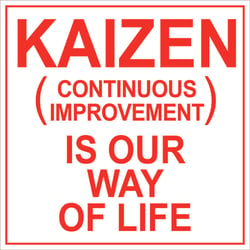 The Merriam-Webster dictionary defines “culture” as, “The set of shared attitudes, values, goals, and practices that characterizes an institution or organization; the characteristic features of everyday existence shared by people in a place or time.” Organizations interested in achieving continuous improvement through the practice of Kaizen could do no better than to make it a “characteristic feature of everyday existence.” That requires building and maintaining a Kaizen Culture.
The Merriam-Webster dictionary defines “culture” as, “The set of shared attitudes, values, goals, and practices that characterizes an institution or organization; the characteristic features of everyday existence shared by people in a place or time.” Organizations interested in achieving continuous improvement through the practice of Kaizen could do no better than to make it a “characteristic feature of everyday existence.” That requires building and maintaining a Kaizen Culture.
There’s another interesting thing about the definition of the word culture. It shares a root with the word “cultivate,” which means, “to foster the growth of; to improve by labor, care, or study.” Cultivation requires intent, action, and attention. Kaizen culture does as well.
There are a number of things that successful leaders do to instill a Kaizen culture and keep it healthy.
Listen to this Post or Subscribe to the Podcast!
Encourage Challenges to Settled Practices
Inertia is a powerful force in organizations, especially in cases where processes are working well enough. It is fairly easy to get people to suggest improvements in areas where problems are apparent, but it's more difficult to apply innovative thinking to processes that have been the same for a long time. For Kaizen to truly thrive, there must be no sacred cows. Team members must learn to give up convention so that new and better practices can emerge.
Avoid Blame
Improvement work targets processes and workspaces, not people. When changes are made, it is important to frame them in terms of positive results and not point fingers at the person or people who designed the old process. People will be much more likely to engage in Kaizen practices if improvement efforts don’t feel punitive.
Say “Yes” as Often as Possible
There will always be a reason not to execute on an opportunity for improvement. Maybe the expected improvement isn’t big enough, or there are other, more pressing problems. Whenever possible, leaders should avoid blocking efforts to improve. Unless there is a big downside, experimentation (within reason) should be encouraged. Not every change needs to have a huge ROI. When people are allowed to run with their ideas, they are more likely to keep making suggestions and become more emotionally invested in the outcome.
Focus on Teamwork
Kaizen is a team sport. Cross-functional collaboration is often essential to efficient processes and a frictionless value stream. Both individual initiative and team effort is needed in a Kaizen culture. Systems that make communication easy and track projects involving multiple people go a long way toward streamlining teamwork.
Model Kaizen from the Top
When Kaizen, or any other business methodology or philosophy, is introduced, the staff will have a keen eye on top leadership to decide if this is a real and lasting change or just a fleeting episode. Successful leaders signal in many ways that they are serious about Kaizen. One way is to invest in solutions that support it. Another is to actively participate in improvement processes right alongside front line employees. It is also essential to recognize and reward the people who exemplify Kaizen culture.
All companies have a culture, whether leaders cultivate it or not. A culture of Kaizen won’t happen on accident. If that’s what you’re after, it will take some thought and care. These simple practices are an excellent place to start.




Add a Comment